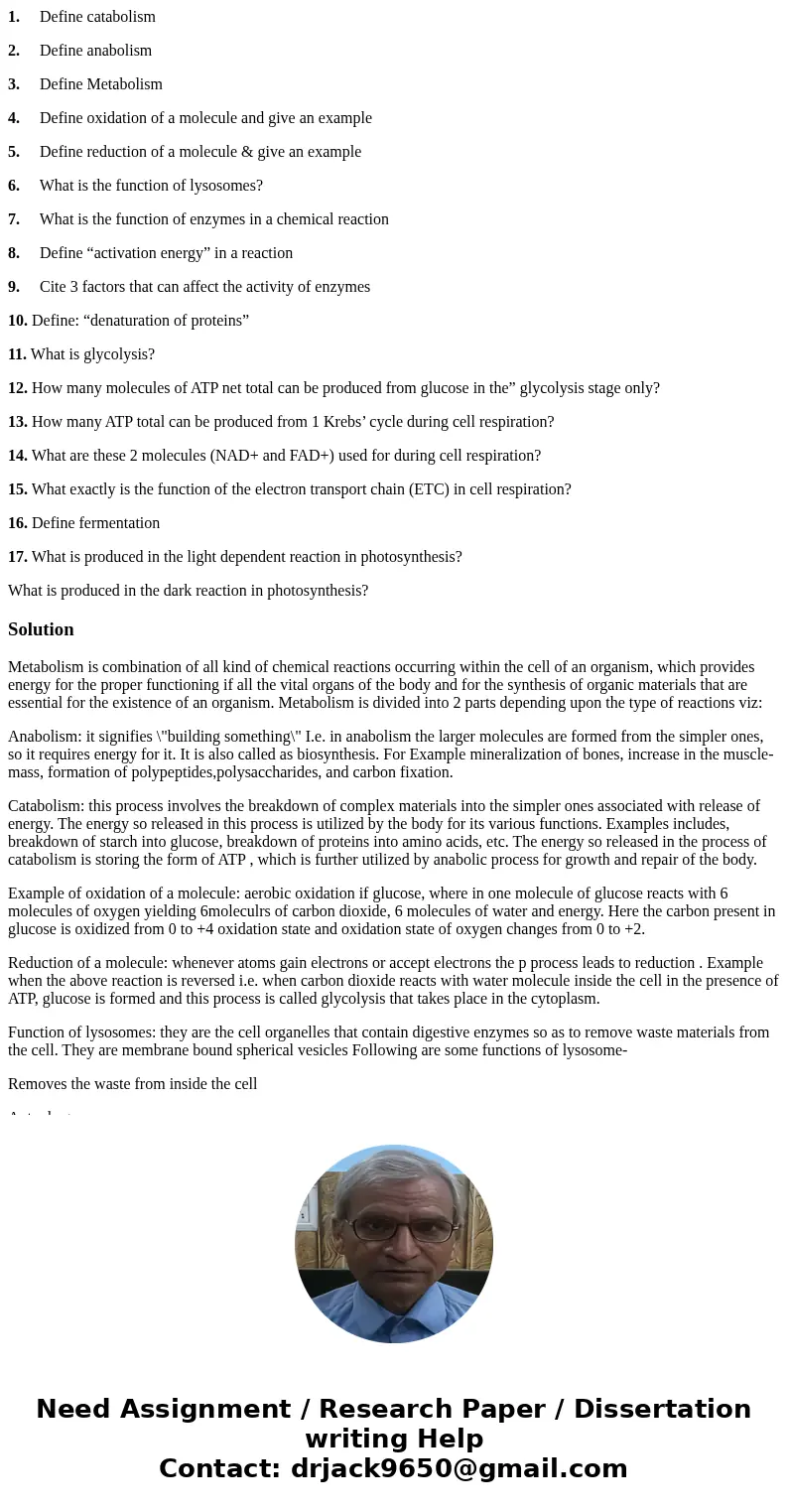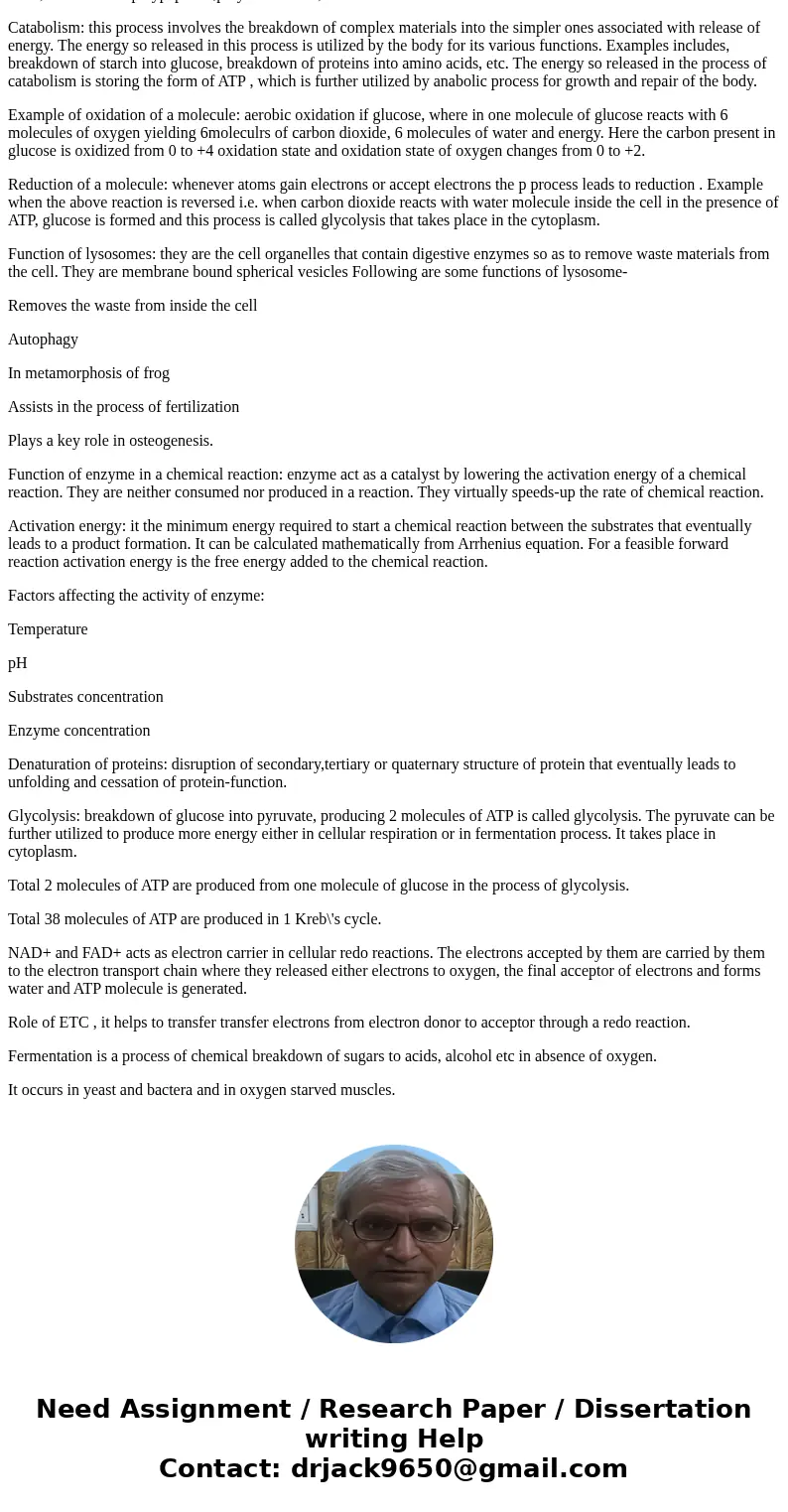1 Define catabolism 2 Define anabolism 3 Define Metabolism 4
1. Define catabolism
2. Define anabolism
3. Define Metabolism
4. Define oxidation of a molecule and give an example
5. Define reduction of a molecule & give an example
6. What is the function of lysosomes?
7. What is the function of enzymes in a chemical reaction
8. Define “activation energy” in a reaction
9. Cite 3 factors that can affect the activity of enzymes
10. Define: “denaturation of proteins”
11. What is glycolysis?
12. How many molecules of ATP net total can be produced from glucose in the” glycolysis stage only?
13. How many ATP total can be produced from 1 Krebs’ cycle during cell respiration?
14. What are these 2 molecules (NAD+ and FAD+) used for during cell respiration?
15. What exactly is the function of the electron transport chain (ETC) in cell respiration?
16. Define fermentation
17. What is produced in the light dependent reaction in photosynthesis?
What is produced in the dark reaction in photosynthesis?
Solution
Metabolism is combination of all kind of chemical reactions occurring within the cell of an organism, which provides energy for the proper functioning if all the vital organs of the body and for the synthesis of organic materials that are essential for the existence of an organism. Metabolism is divided into 2 parts depending upon the type of reactions viz:
Anabolism: it signifies \"building something\" I.e. in anabolism the larger molecules are formed from the simpler ones, so it requires energy for it. It is also called as biosynthesis. For Example mineralization of bones, increase in the muscle-mass, formation of polypeptides,polysaccharides, and carbon fixation.
Catabolism: this process involves the breakdown of complex materials into the simpler ones associated with release of energy. The energy so released in this process is utilized by the body for its various functions. Examples includes, breakdown of starch into glucose, breakdown of proteins into amino acids, etc. The energy so released in the process of catabolism is storing the form of ATP , which is further utilized by anabolic process for growth and repair of the body.
Example of oxidation of a molecule: aerobic oxidation if glucose, where in one molecule of glucose reacts with 6 molecules of oxygen yielding 6moleculrs of carbon dioxide, 6 molecules of water and energy. Here the carbon present in glucose is oxidized from 0 to +4 oxidation state and oxidation state of oxygen changes from 0 to +2.
Reduction of a molecule: whenever atoms gain electrons or accept electrons the p process leads to reduction . Example when the above reaction is reversed i.e. when carbon dioxide reacts with water molecule inside the cell in the presence of ATP, glucose is formed and this process is called glycolysis that takes place in the cytoplasm.
Function of lysosomes: they are the cell organelles that contain digestive enzymes so as to remove waste materials from the cell. They are membrane bound spherical vesicles Following are some functions of lysosome-
Removes the waste from inside the cell
Autophagy
In metamorphosis of frog
Assists in the process of fertilization
Plays a key role in osteogenesis.
Function of enzyme in a chemical reaction: enzyme act as a catalyst by lowering the activation energy of a chemical reaction. They are neither consumed nor produced in a reaction. They virtually speeds-up the rate of chemical reaction.
Activation energy: it the minimum energy required to start a chemical reaction between the substrates that eventually leads to a product formation. It can be calculated mathematically from Arrhenius equation. For a feasible forward reaction activation energy is the free energy added to the chemical reaction.
Factors affecting the activity of enzyme:
Temperature
pH
Substrates concentration
Enzyme concentration
Denaturation of proteins: disruption of secondary,tertiary or quaternary structure of protein that eventually leads to unfolding and cessation of protein-function.
Glycolysis: breakdown of glucose into pyruvate, producing 2 molecules of ATP is called glycolysis. The pyruvate can be further utilized to produce more energy either in cellular respiration or in fermentation process. It takes place in cytoplasm.
Total 2 molecules of ATP are produced from one molecule of glucose in the process of glycolysis.
Total 38 molecules of ATP are produced in 1 Kreb\'s cycle.
NAD+ and FAD+ acts as electron carrier in cellular redo reactions. The electrons accepted by them are carried by them to the electron transport chain where they released either electrons to oxygen, the final acceptor of electrons and forms water and ATP molecule is generated.
Role of ETC , it helps to transfer transfer electrons from electron donor to acceptor through a redo reaction.
Fermentation is a process of chemical breakdown of sugars to acids, alcohol etc in absence of oxygen.
It occurs in yeast and bactera and in oxygen starved muscles.


 Homework Sourse
Homework Sourse